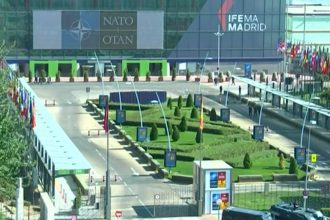
The NATO Summit, which had widespread media coverage, was held in Madrid from 28 to 30 June and undoubtedly served to strengthen the city’s international image with regards to professional event organisation. Appearing in articles and reports, as well as in the press and on TV, for weeks Madrid and its tourist offerings were news material for the global media.
The end result was the product of combined effort and coordination between the professional sector and multiple institutions. In terms of event organisation, the summit seems to have greatly exceeded the expectations of some of the foreign organisers and participants, who have repeatedly spoken highly of their experience in Madrid. A summary, in figures, of the international NATO Summit is given below:
Venue: IFEMA Madrid, Halls 12 and 14, an area of 50,000 square metres for rooms to host the summit itself and for facilities to accommodate over 2,000 accredited reporters, as well as 100,000 additional square metres. For more details on the event organised at IFEMA Madrid, click here.
Participants: over 5,000 from 45 different countries, including representatives from NATO member states as well as guests or participants at parallel meetings.
Budget*: €50 million *(data published by different media sources).
Average hotel occupancy: 70%, according to the Madrid Hotel Business Association (AEHM), in 4-star and 5-star hotels, especially along the Paseo de la Castellana avenue and in the vicinity of the trade fair centre. For more information on hotel occupancy, click here.
Direct impact on Madrid: €150 million, according to the Madrid City Council.
Flights: over 100 aircraft owned by the different delegations, with a special security and control unit in place.
Social event venues: Gala dinners were hosted by the Prado Museum and the Royal Palace. The programme for accompanying guests included a visit to the Reina Sofía Museum, NuBel restaurant and the Teatro Real opera house.
The world’s top cultural destination
What stood out most was how some of the social events organised really highlighted Madrid’s status as one of the world’s top cultural destinations. For example, the decision to host one of the gala dinners at the Prado Museum, as well as the tour of the Reina Sofía Museum which was included in the programme for accompanying guests.
Two world-famous artworks were chosen as the backdrops for two of the family photos taken during the summit: Picasso´s Guernica at the Reina Sofía Museum, for the accompanying guests; and Las Meninas, at the Prado Museum, for the attendees of the dinner held at the iconic institution.
Spanish gastronomy was also at the fore, in both the official summit programme as well as in the programme organised for accompanying guests. Paco Roncero was chosen as the chef for the dinner held at the Royal Palace, and his aim was to design a menu that brought together a range of ingredients and dishes from Spanish cuisine. Chef José Andrés was responsible for the dinner at the Prado Museum, for which he drew inspiration from the gastronomy of Madrid.
A unique programme of activities
The media’s focus wasn’t just on IFEMA Madrid´s trade fair centre and what was happening on its grounds. The programme organised for accompanying guests also received widespread media coverage and was a “textbook” example that showcased the highlights of a destination which, to many of the attendees, was virtually unknown.
Participants used the AVE high-speed rail network, which has its hub in Madrid, and found out first-hand how easy it is to travel within Spain. With respect to Madrid itself, they saw that travelling to nearby UNESCO World Heritage Sites, such as Segovia and Toledo, was very straightforward.
In terms of culture, which had a notable presence in the programme, participants received a private tour of the Reina Sofía Museum. This was followed by lunch at its restaurant, NuBel, a prime example of contemporary architectural design.
Guests also visited another iconic building in central Madrid, Teatro Real, where they watched a rehearsal of the opera Nabucco and a short recital by Kiki Morente, which gave them a brief insight into the universal art of flamenco.
The programme also included a group activity: a tasting of extra-virgin olive oil as an example of an internationally renowned local Spanish product.
Other interesting facts
Aside from the public spirit of Madrid’s residents during the summit and the event´s impeccable institutional collaboration, which included handling the security requirements imposed by NATO, other notable aspects of the event are highlighted below:
Traffic in Madrid fell by 30%, while demand for public transport, including both the metro and the bus, increased.
The meeting rooms at IFEMA were decorated with elements alluding to different places in Spain, such as the Generalife, Roque de los Muchachos, Segovia and Olite Castle. This provided another opportunity for participants to learn more about Spain.
In a nod to Ukraine, the Kiev Symphony Orchestra was chosen to give a pre-dinner concert for attendees of the evening at the Prado Museum.
The summit logo combined NATO’s official logo with the Spanish coat of arms in the red and yellow colours of the national flag. The latter showed the castle, the rampant lion, the four pales and the chains which respectively symbolise the kingdoms of Castile, León, Aragon and Navarre. The left side of the logo featured NATO’s four-point star pointed symbolically towards the member states located in different directions around the Atlantic Ocean.
In summary, in terms of promotion and organisation, Madrid demonstrated its savoir faire, offering very exclusive examples of some of its main features: top-class culture, gastronomy, and flamenco art. In addition, the city’s tourism and MICE sector showed its professionalism with exceptional organisation of social events in historic, emblematic buildings like the Prado and Reina Sofía museums, outstanding management of the summit at IFEMA, first-rate hotels, and suppliers and transport services that met the stringent requirements of the international delegations which, over the three days, took part in the NATO Summit. This professional event came exactly 25 years after Madrid first hosted the summit.

